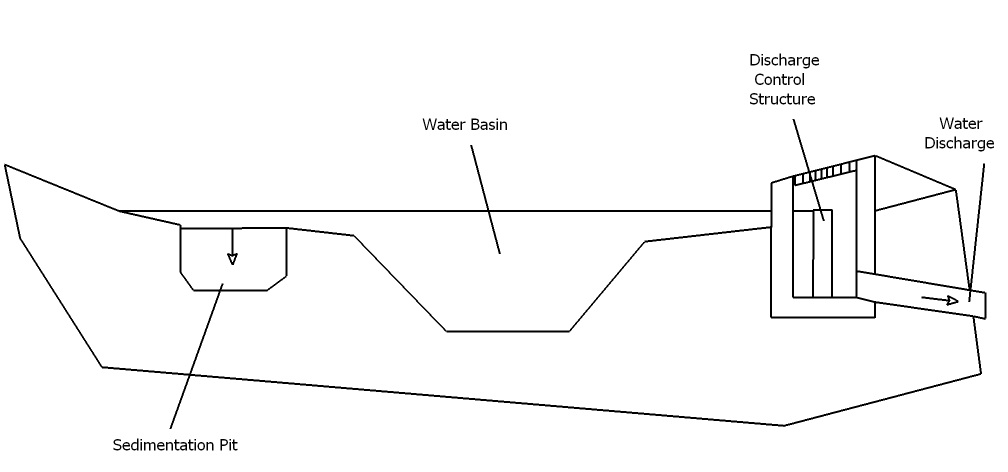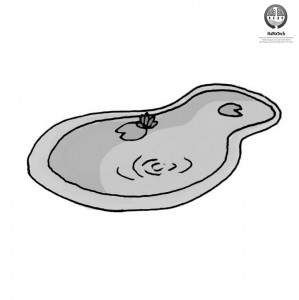Retention basins are predominantly used for storm water control and treatment. Rainwater is stored in a pond, which further filters through the sediments and soil column and in the process recharges the aquifer. The retention basin prevents successional flooding by storing the water in a confined area. Due to the flow of water through the soil water gets treated naturally before reaching the aquifer. Water from the retention basin can be used in irrigation, industry or at household level after an appropriate secondary treatment. Nutrients are removed effectively because of the photosynthetic activities and bacteria attached to the plants.
| The contents of this factsheet are results of the Indo-European Project NaWaTech- “Natural Water Systems and Treatment Technologies to cope with Water Shortages in Urbanised Areas in India”, co-financed by the EC and the DST – India. |

Retention basins require limited maintenance. Permanent access must be provided to the embankment areas for preventive maintenance, which includes control of erosion and suspension of sediments. This should be done to reduce unwanted sediment export. The routine maintenance includes quarterly inspections of inlet and outlets, sediments, trash dredging, repairs to the embankment, control of algal growth, insects and dour (SEWRPC 1991). The retention basin should be inspected after every storm.
The capital cost for construction of retention basins includes the land and excavation cost. High investment is required for the construction of retention predominantly due to the land cost. The cost varies depending on the location and the area required. Retention basin has minimum maintenance cost and usually lasts for over 20 years. Once in operation, only minimal maintenance cost arises. Retrofitting retention basin in a developed area is usually expensive owing to the high land costs. Retention basin is built at a community level by the local authority or large area land developer.
A retention basin is used to manage storm water to prevent flooding, soil erosion and control transport of pollutants carried by rainfall runoff. It is an artificial lake designed to carry a permanent pool of water. Retention basins have been extensively studied in the US, Canada, South-East Asia and parts of Europe (SEWRPC 1991; BORDEN et al. 1996; SAUNDERS & GILROY 1997; WAKELIN et al. 2003). Along the Czech Republic – Germany border the implementation of retention basin reduced storm water runoff peak flows by up to 48% (REINHARDT 2012). In recent years, there has been increased focus on optimising the design of retention basins for the purpose of maximising cost savings. Studies have also been carried out in Germany to assess the ecological impact of retention basins (REINHARDT 2012). Along with the improvements in the water quality and habitat, the adverse impact of change in the hydrological conditions resulted in the modification of the vegetation in the region (SCHOLZ 2007).
Retention basins offer a viable solution to the problem of urban storm water runoff in developing countries. Due to financial constraints and lack of infrastructure, wastewater management systems are not well equipped to treat sudden increase in hydraulic load due to rain or floods. Retention basins offer an inexpensive and sustainable drainage solution to this problem. Studies show that incorporating retention basins to conventional drainage networks can prevent flooding in receiving bodies and transport of oil, organics and toxic metals through storm water runoff (CIDCO 2013). Retention basins or holding ponds have been constructed in coastal Navi Mumbai to avoid water logging of low lying areas and prevent pollutants to flow into the creek (CIDCO 2013). In Mumbai, retention basin was effective in storm water flooding and reducing the total suspended solids (ZOPE & SAWANT 2008).
In rural India, retention basins have been used for centuries for holding rainfall to augment drinking water and irrigation supply. Case studies have been reported from various parts of India including Hyderabad, Surat and Karnataka (NIDM 2009). These local initiatives have been successful in preventing flooding in areas with heavy rainfall and preventing water scarcity in desert areas.
For more information please visit: (Retention Basin)
| The research leading to these results has received funding from the European Union Seventh Framework Programme ([FP7/2007-2013]) under Grant Agreement N° [308336] and the Department of Science and Technology of the Government of India DS.O DST/IMRCD/NaWaTech/ 2012/(G). |
Evaluation of Ponds and Wetlands for Protection of Public Water Supplies
Environmental Infrastructure
45% of Navi Mumbai's land has been set aside for greenery and open-to-sky uses. As a custodian of this land, CIDCO has always been vigilant about protecting this greenery. Soon after its inception, CIDCO established a full-fledged Horticulture Department for development of the 'greens' in Navi Mumbai. The very objective of this was to convert and cover the barren hills and low-lying lands into a green and sustainable human settlement.
CIDCO (2013): Environmental Infrastructure. Mumbai: City and Industrial Development Corporation of Maharashtra Ltd. URL [Accessed: 09.08.2013]Disaster & Development
CONTENTS Urban Floods: Case Study of Bangalore (T. V. Ramachandra and Pradeep P. Mujumdar) Urban Floods: Case Study of Mumbai (Kapil Gupta) Urban Floods: Case Study of Hyderabad (Kalpana Markandeya and G. Suryanarayana) Urban Floods: Case Study of Surat (N. J. Mistry) Flood Disaster Mitigation and Management: A Synthesis and Key Lessons (Anil Kumar Gupta)
NIDM (2009): Disaster & Development. Special Issue: Urban Floods-II. (= Journal of the National Institute of Disaster Management , 2 / 3 ). New Delhi: National Institute of Disaster Management URL [Accessed: 17.03.2015]Decentralised Flood Protection
Treatment of Nonpoint Source Pollution with Wetland/Aquatic Ecosystem Best Management Practices
Ecological Effects of Water Retention in the River Rhine Valley
This review paper summarizes the ecological effects of the use of floodplains and flood retention basins to control river flow in the River Rhine (Rhein) valley. Early River Rhine regulation strategies including channel straightening are assessed. The subsequent disappearance of alluvial hardwood forests has been highlighted as the major disadvantage. The response of trees to more recent strategies such as ecological flooding is also assessed. Water quality and habitat improvements due to these ecological control techniques are identified as effective. The development of flood retention basin classification methodologies and floodplain management decision support systems particularly for the upper River Rhine Valley is recommended. The purpose is to aid communication among engineers and scientists, and to promote a holistic, integrated and international water resources management strategy, which would be relevant not only for the River Rhine valley but also for similar rivers in a temperate climate.
SCHOLZ, M. (2007): Ecological Effects of Water Retention in the River Rhine Valley. A Review Assisting Future Retention Basin Classification. In: International Journal of Environmental Studies: Volume 64 , 171-187. URL [Accessed: 17.03.2015]Costs for Urban Nonpoint Source Water Pollution Control Measures
Assessment of Stormwater Retention Basin Water Quality in Winnipeg, Canada
The water quality behaviour of 58 stormwater retention basins in Winnipeg, Canada, was intensively studied during a 5-month summer period (May to September). Dissolved oxygen (DO), temperature, turbidity, transparency and depth were measured onsite. Samples analyzed in the laboratory included: total suspended solids (TSS), pH, chlorophyll a, fecal coliforms (FC), total kjeldahl nitrogen (TKN), ammonia, nitrate, total phosphorus (TP) and orthophosphate. Results showed that increases in TSS and turbidity resulted from increased chlorophyll a concentrations associated with algal growth. TKN increases were partly the result of nitrogen incorporation into proteinaceous material in the algal cells. Ammonia concentrations showed a maximum attributed to chemo-heterotrophic degradation of dead biomass. Orthophosphate made up 30% to 50% of the total phosphorus present and the two followed the same general trends. Temperature increased and then decreased over the summer months with no apparent thermal stratification. After starting the summer with no dis-solved oxygen gradient between top and bottom, depletion of the dissolved oxygen at the bottom of the basins during the latter half of the summer was attributed to chemoheterotrophic degradation of dead biomass. Finally, sub-stantial counts of fecal coliform bacteria occurred in the basins in response to Canada geese migration.
WAKELIN, S. ; ELEFSINIOTIS, P. ; WAREHAM, D. (2003): Assessment of Stormwater Retention Basin Water Quality in Winnipeg, Canada. In: Water Quality Research Journal of Canada: Volume 38 , 433-450.Characterisation of Urban Storm Water Runoff
National Pollutant Discharge Elimination System
Water pollution degrades surface waters making them unsafe for drinking, fishing, swimming, and other activities. As authorized by the Clean Water Act, the National Pollutant Discharge Elimination System (NPDES) permit program controls water pollution by regulating point sources that discharge pollutants into waters of the United States. Point sources are discrete conveyances such as pipes or man-made ditches. Individual homes that are connected to a municipal system, use a septic system, or do not have a surface discharge do not need an NPDES permit; however, industrial, municipal, and other facilities must obtain permits if their discharges go directly to surface waters. In most cases, the NPDES permit program is administered by authorized states. Since its introduction in 1972, the NPDES permit program is responsible for significant improvements to our Nation's water quality.
EPA (2013): National Pollutant Discharge Elimination System. Washington: United States Environmental Protection AgencyCompendium of Natural Water Systems and Treatment Technologies to cope with Water Shortages in Urbanised Areas in India
The Compendium of NaWaTech Technologies presents appropriate water and wastewater technologies that could enable the sustainable water management in Indian cities. It is intended as a reference for water professionals in charge of planning, designing and implementing sustainable water systems in the Indian urban scenario, based on a decentralised approach.
BARRETO DILLON, L. ; DOYLE, L. ; LANGERGRABER, G. ; SATISH, S. ; POPHALI, G. (2013): Compendium of Natural Water Systems and Treatment Technologies to cope with Water Shortages in Urbanised Areas in India. Berlin: EPUBLI GMBH URL [Accessed: 11.12.2015]http://www.nawatech.net/
This is the official webpage of the NaWaTech Collaborative Project, containing all key information related to the different case studies, activities and results of the project.



